Report: Agile Software Development Evolution and Analysis
VerifiedAdded on 2022/10/19
|6
|1457
|7
Report
AI Summary
This report analyzes the article "A decade of agile methodologies: Towards explaining agile software development," which examines research on agile software development from 2001 to 2010. The study reviews the principles of agile software development, contributions from conferences, and theoretical concepts, focusing on the evolution since the agile manifesto. The report highlights the methodology's emphasis on customer satisfaction and flexibility. It also discusses challenges, such as limited global recognition of research and a lack of formal guidelines. The analysis covers research trends, publications, and the adoption of agile methodologies. The report concludes by emphasizing the need for formal guidelines and future research directions, offering valuable insights for software engineering methodologies and stakeholders. The study is relevant to the unit, software engineering methodologies in that, it addresses critical aspects that agile methodology is based on. These aspects cover agile software development principles and pertinent issues that should be considered by all stakeholders. It provides some recommendations that developers adopting agile methodology should be aware of before putting it into practice.
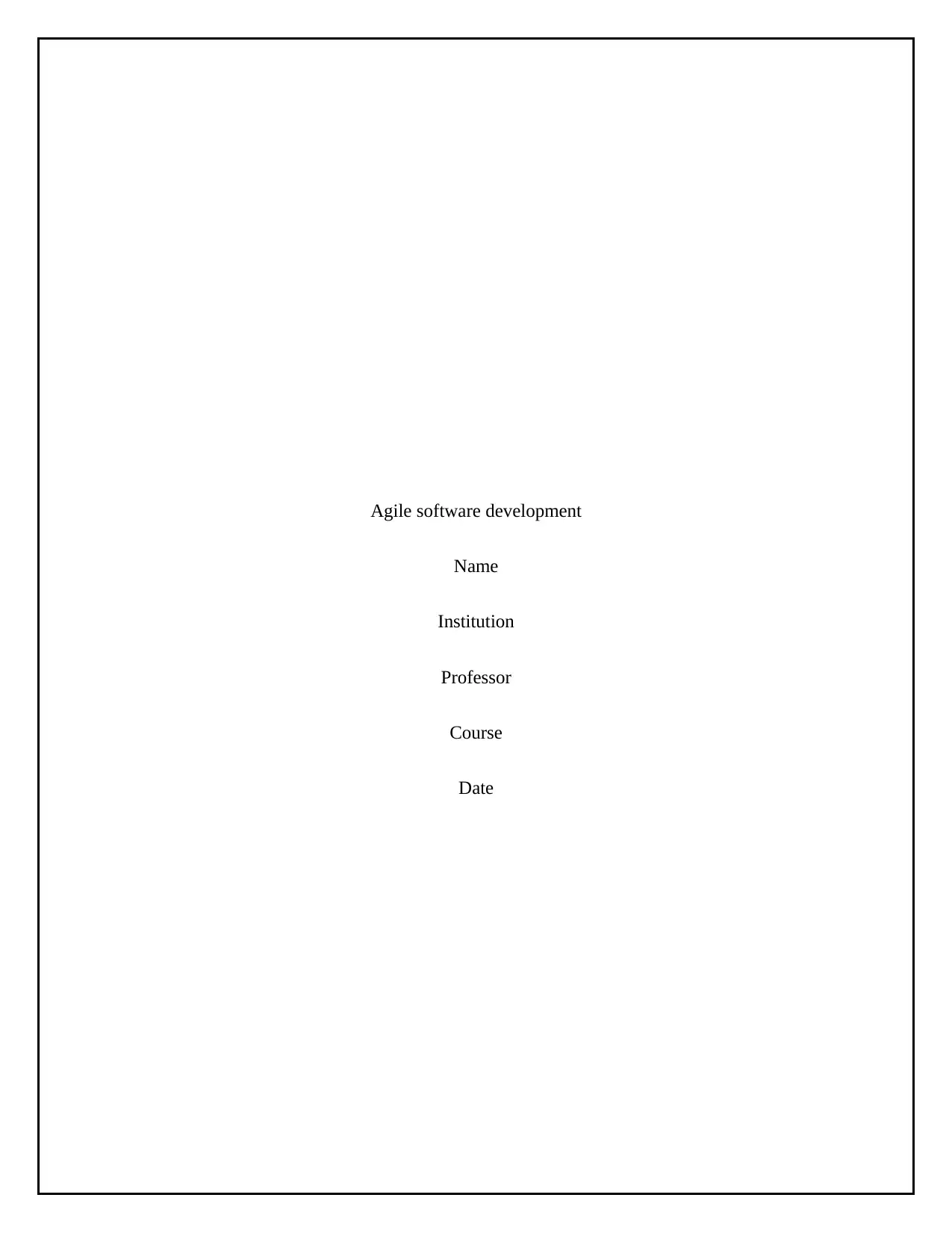
Agile software development
Name
Institution
Professor
Course
Date
Name
Institution
Professor
Course
Date
Paraphrase This Document
Need a fresh take? Get an instant paraphrase of this document with our AI Paraphraser
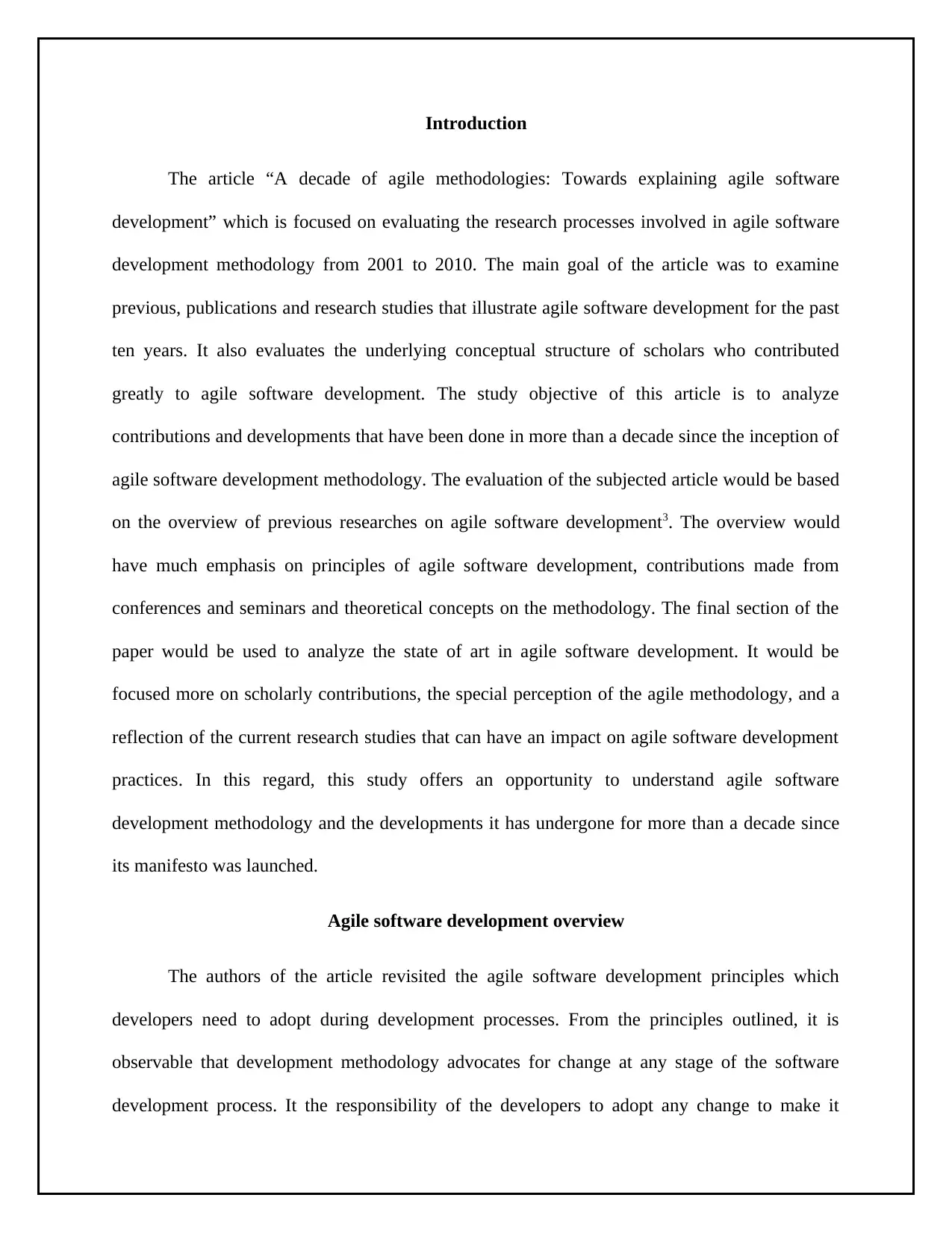
Introduction
The article “A decade of agile methodologies: Towards explaining agile software
development” which is focused on evaluating the research processes involved in agile software
development methodology from 2001 to 2010. The main goal of the article was to examine
previous, publications and research studies that illustrate agile software development for the past
ten years. It also evaluates the underlying conceptual structure of scholars who contributed
greatly to agile software development. The study objective of this article is to analyze
contributions and developments that have been done in more than a decade since the inception of
agile software development methodology. The evaluation of the subjected article would be based
on the overview of previous researches on agile software development3. The overview would
have much emphasis on principles of agile software development, contributions made from
conferences and seminars and theoretical concepts on the methodology. The final section of the
paper would be used to analyze the state of art in agile software development. It would be
focused more on scholarly contributions, the special perception of the agile methodology, and a
reflection of the current research studies that can have an impact on agile software development
practices. In this regard, this study offers an opportunity to understand agile software
development methodology and the developments it has undergone for more than a decade since
its manifesto was launched.
Agile software development overview
The authors of the article revisited the agile software development principles which
developers need to adopt during development processes. From the principles outlined, it is
observable that development methodology advocates for change at any stage of the software
development process. It the responsibility of the developers to adopt any change to make it
The article “A decade of agile methodologies: Towards explaining agile software
development” which is focused on evaluating the research processes involved in agile software
development methodology from 2001 to 2010. The main goal of the article was to examine
previous, publications and research studies that illustrate agile software development for the past
ten years. It also evaluates the underlying conceptual structure of scholars who contributed
greatly to agile software development. The study objective of this article is to analyze
contributions and developments that have been done in more than a decade since the inception of
agile software development methodology. The evaluation of the subjected article would be based
on the overview of previous researches on agile software development3. The overview would
have much emphasis on principles of agile software development, contributions made from
conferences and seminars and theoretical concepts on the methodology. The final section of the
paper would be used to analyze the state of art in agile software development. It would be
focused more on scholarly contributions, the special perception of the agile methodology, and a
reflection of the current research studies that can have an impact on agile software development
practices. In this regard, this study offers an opportunity to understand agile software
development methodology and the developments it has undergone for more than a decade since
its manifesto was launched.
Agile software development overview
The authors of the article revisited the agile software development principles which
developers need to adopt during development processes. From the principles outlined, it is
observable that development methodology advocates for change at any stage of the software
development process. It the responsibility of the developers to adopt any change to make it
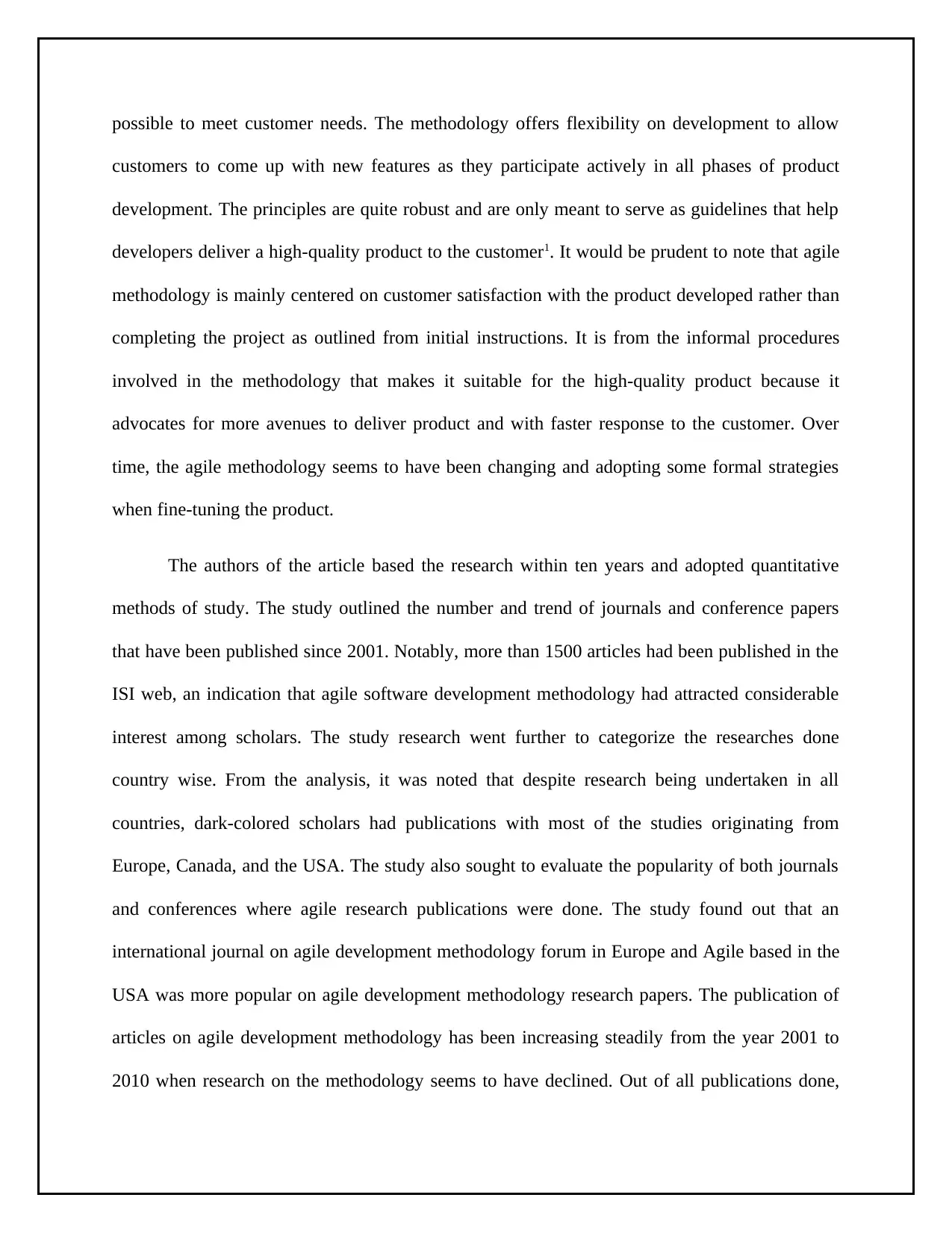
possible to meet customer needs. The methodology offers flexibility on development to allow
customers to come up with new features as they participate actively in all phases of product
development. The principles are quite robust and are only meant to serve as guidelines that help
developers deliver a high-quality product to the customer1. It would be prudent to note that agile
methodology is mainly centered on customer satisfaction with the product developed rather than
completing the project as outlined from initial instructions. It is from the informal procedures
involved in the methodology that makes it suitable for the high-quality product because it
advocates for more avenues to deliver product and with faster response to the customer. Over
time, the agile methodology seems to have been changing and adopting some formal strategies
when fine-tuning the product.
The authors of the article based the research within ten years and adopted quantitative
methods of study. The study outlined the number and trend of journals and conference papers
that have been published since 2001. Notably, more than 1500 articles had been published in the
ISI web, an indication that agile software development methodology had attracted considerable
interest among scholars. The study research went further to categorize the researches done
country wise. From the analysis, it was noted that despite research being undertaken in all
countries, dark-colored scholars had publications with most of the studies originating from
Europe, Canada, and the USA. The study also sought to evaluate the popularity of both journals
and conferences where agile research publications were done. The study found out that an
international journal on agile development methodology forum in Europe and Agile based in the
USA was more popular on agile development methodology research papers. The publication of
articles on agile development methodology has been increasing steadily from the year 2001 to
2010 when research on the methodology seems to have declined. Out of all publications done,
customers to come up with new features as they participate actively in all phases of product
development. The principles are quite robust and are only meant to serve as guidelines that help
developers deliver a high-quality product to the customer1. It would be prudent to note that agile
methodology is mainly centered on customer satisfaction with the product developed rather than
completing the project as outlined from initial instructions. It is from the informal procedures
involved in the methodology that makes it suitable for the high-quality product because it
advocates for more avenues to deliver product and with faster response to the customer. Over
time, the agile methodology seems to have been changing and adopting some formal strategies
when fine-tuning the product.
The authors of the article based the research within ten years and adopted quantitative
methods of study. The study outlined the number and trend of journals and conference papers
that have been published since 2001. Notably, more than 1500 articles had been published in the
ISI web, an indication that agile software development methodology had attracted considerable
interest among scholars. The study research went further to categorize the researches done
country wise. From the analysis, it was noted that despite research being undertaken in all
countries, dark-colored scholars had publications with most of the studies originating from
Europe, Canada, and the USA. The study also sought to evaluate the popularity of both journals
and conferences where agile research publications were done. The study found out that an
international journal on agile development methodology forum in Europe and Agile based in the
USA was more popular on agile development methodology research papers. The publication of
articles on agile development methodology has been increasing steadily from the year 2001 to
2010 when research on the methodology seems to have declined. Out of all publications done,
⊘ This is a preview!⊘
Do you want full access?
Subscribe today to unlock all pages.

Trusted by 1+ million students worldwide
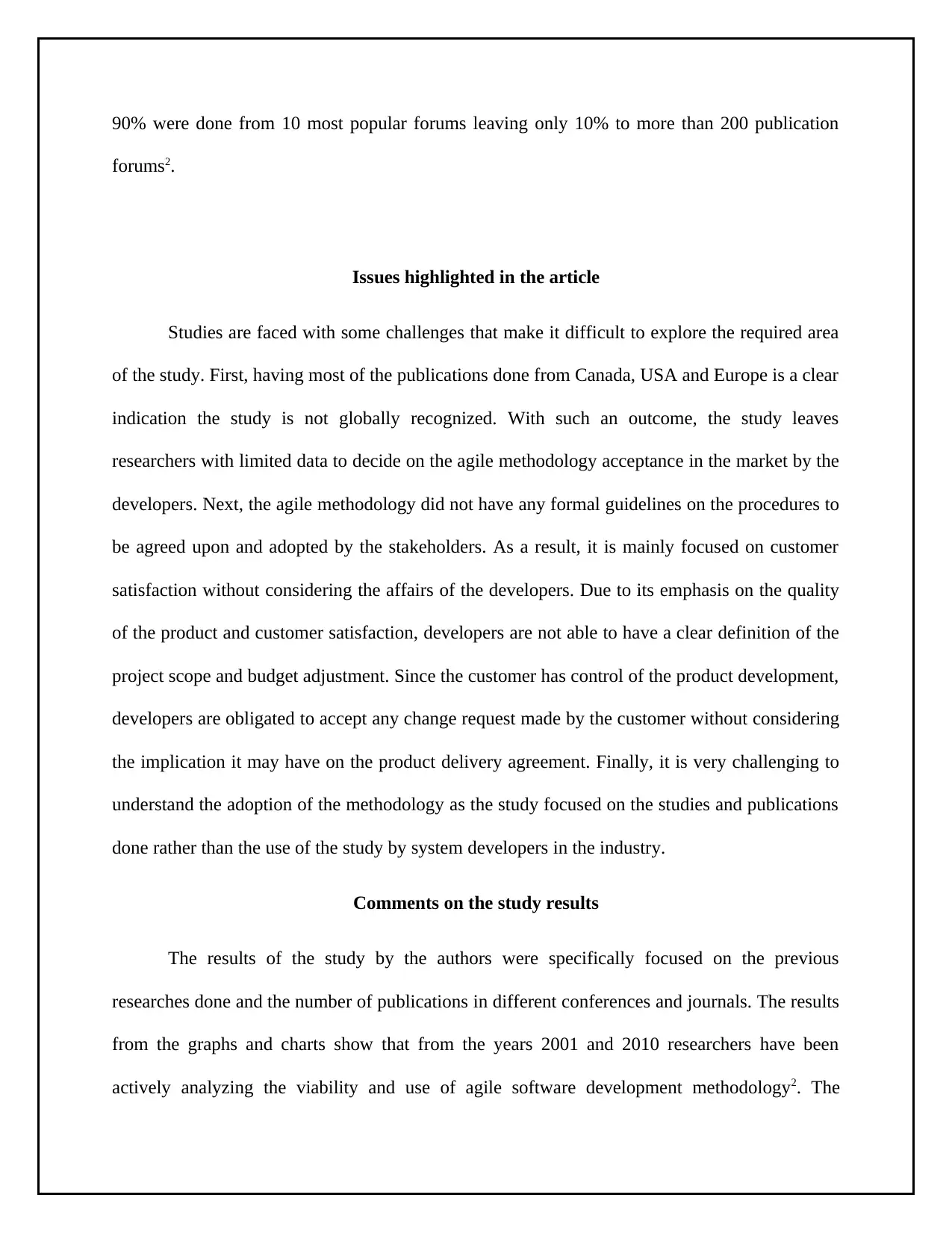
90% were done from 10 most popular forums leaving only 10% to more than 200 publication
forums2.
Issues highlighted in the article
Studies are faced with some challenges that make it difficult to explore the required area
of the study. First, having most of the publications done from Canada, USA and Europe is a clear
indication the study is not globally recognized. With such an outcome, the study leaves
researchers with limited data to decide on the agile methodology acceptance in the market by the
developers. Next, the agile methodology did not have any formal guidelines on the procedures to
be agreed upon and adopted by the stakeholders. As a result, it is mainly focused on customer
satisfaction without considering the affairs of the developers. Due to its emphasis on the quality
of the product and customer satisfaction, developers are not able to have a clear definition of the
project scope and budget adjustment. Since the customer has control of the product development,
developers are obligated to accept any change request made by the customer without considering
the implication it may have on the product delivery agreement. Finally, it is very challenging to
understand the adoption of the methodology as the study focused on the studies and publications
done rather than the use of the study by system developers in the industry.
Comments on the study results
The results of the study by the authors were specifically focused on the previous
researches done and the number of publications in different conferences and journals. The results
from the graphs and charts show that from the years 2001 and 2010 researchers have been
actively analyzing the viability and use of agile software development methodology2. The
forums2.
Issues highlighted in the article
Studies are faced with some challenges that make it difficult to explore the required area
of the study. First, having most of the publications done from Canada, USA and Europe is a clear
indication the study is not globally recognized. With such an outcome, the study leaves
researchers with limited data to decide on the agile methodology acceptance in the market by the
developers. Next, the agile methodology did not have any formal guidelines on the procedures to
be agreed upon and adopted by the stakeholders. As a result, it is mainly focused on customer
satisfaction without considering the affairs of the developers. Due to its emphasis on the quality
of the product and customer satisfaction, developers are not able to have a clear definition of the
project scope and budget adjustment. Since the customer has control of the product development,
developers are obligated to accept any change request made by the customer without considering
the implication it may have on the product delivery agreement. Finally, it is very challenging to
understand the adoption of the methodology as the study focused on the studies and publications
done rather than the use of the study by system developers in the industry.
Comments on the study results
The results of the study by the authors were specifically focused on the previous
researches done and the number of publications in different conferences and journals. The results
from the graphs and charts show that from the years 2001 and 2010 researchers have been
actively analyzing the viability and use of agile software development methodology2. The
Paraphrase This Document
Need a fresh take? Get an instant paraphrase of this document with our AI Paraphraser
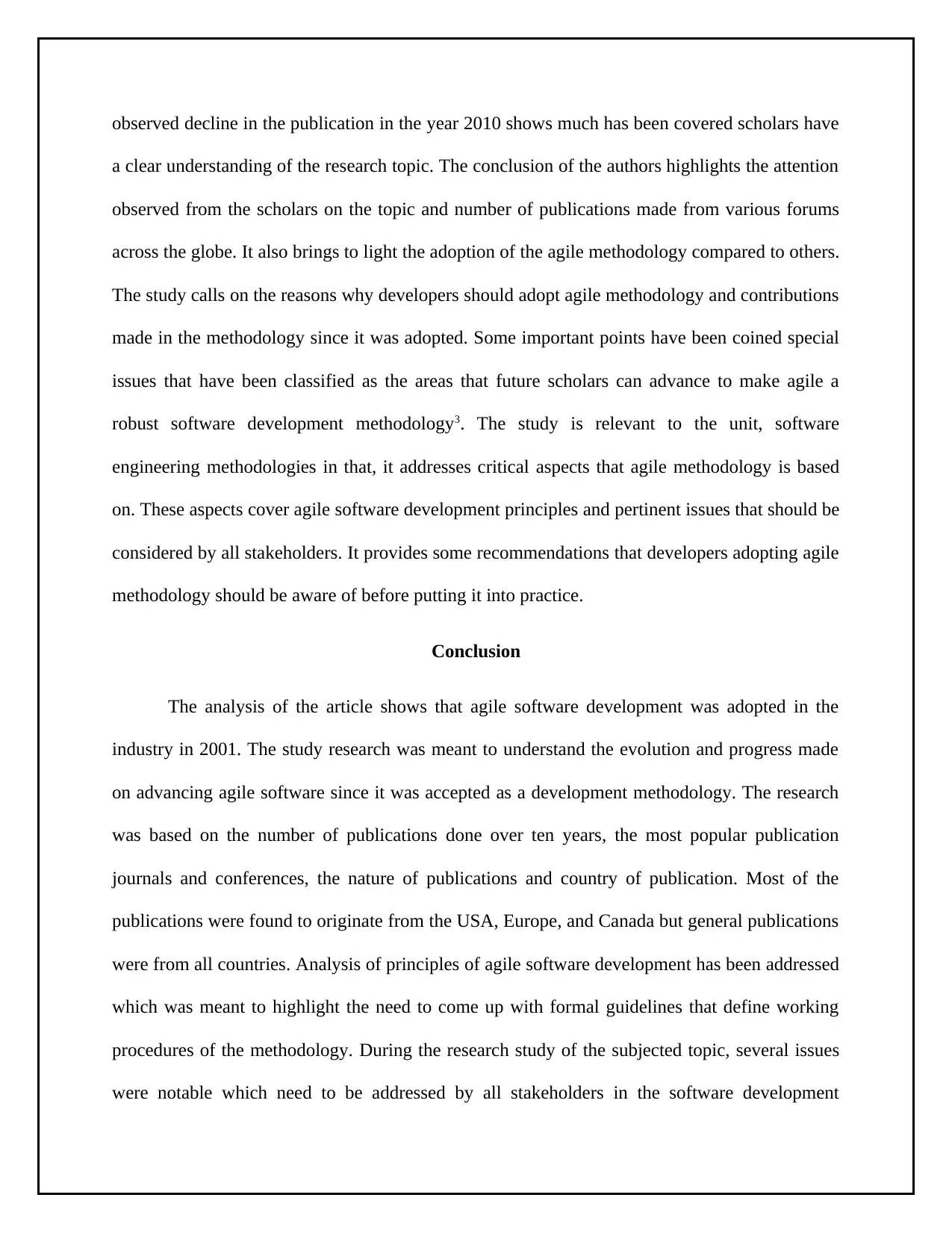
observed decline in the publication in the year 2010 shows much has been covered scholars have
a clear understanding of the research topic. The conclusion of the authors highlights the attention
observed from the scholars on the topic and number of publications made from various forums
across the globe. It also brings to light the adoption of the agile methodology compared to others.
The study calls on the reasons why developers should adopt agile methodology and contributions
made in the methodology since it was adopted. Some important points have been coined special
issues that have been classified as the areas that future scholars can advance to make agile a
robust software development methodology3. The study is relevant to the unit, software
engineering methodologies in that, it addresses critical aspects that agile methodology is based
on. These aspects cover agile software development principles and pertinent issues that should be
considered by all stakeholders. It provides some recommendations that developers adopting agile
methodology should be aware of before putting it into practice.
Conclusion
The analysis of the article shows that agile software development was adopted in the
industry in 2001. The study research was meant to understand the evolution and progress made
on advancing agile software since it was accepted as a development methodology. The research
was based on the number of publications done over ten years, the most popular publication
journals and conferences, the nature of publications and country of publication. Most of the
publications were found to originate from the USA, Europe, and Canada but general publications
were from all countries. Analysis of principles of agile software development has been addressed
which was meant to highlight the need to come up with formal guidelines that define working
procedures of the methodology. During the research study of the subjected topic, several issues
were notable which need to be addressed by all stakeholders in the software development
a clear understanding of the research topic. The conclusion of the authors highlights the attention
observed from the scholars on the topic and number of publications made from various forums
across the globe. It also brings to light the adoption of the agile methodology compared to others.
The study calls on the reasons why developers should adopt agile methodology and contributions
made in the methodology since it was adopted. Some important points have been coined special
issues that have been classified as the areas that future scholars can advance to make agile a
robust software development methodology3. The study is relevant to the unit, software
engineering methodologies in that, it addresses critical aspects that agile methodology is based
on. These aspects cover agile software development principles and pertinent issues that should be
considered by all stakeholders. It provides some recommendations that developers adopting agile
methodology should be aware of before putting it into practice.
Conclusion
The analysis of the article shows that agile software development was adopted in the
industry in 2001. The study research was meant to understand the evolution and progress made
on advancing agile software since it was accepted as a development methodology. The research
was based on the number of publications done over ten years, the most popular publication
journals and conferences, the nature of publications and country of publication. Most of the
publications were found to originate from the USA, Europe, and Canada but general publications
were from all countries. Analysis of principles of agile software development has been addressed
which was meant to highlight the need to come up with formal guidelines that define working
procedures of the methodology. During the research study of the subjected topic, several issues
were notable which need to be addressed by all stakeholders in the software development

industry. From the analysis, it has been observed that different scholars from various parts of the
world have been involved in the study of the agile development methodology. As a result, within
10 years since its adoption, the number of scholars interested in its study has been increasing
over time.
References
[1].Al-Zewairi, Malek, Mariam Biltawi, Wael Etaiwi, & Adnan Shaout. "Agile software
development methodologies: survey of surveys." Journal of Computer and Communications,
2017, pp. 74-97.
[2].Balijepally, VenuGopal, & Sridhar Nerur. "Understanding the Structure of Agile Software
Development Using Text Analytics: A Preliminary Analysis", 2015, pp. 1-8.
[3].Dingsoyr, Torgeir, Sridhar Nerur, VenuGopal Balijepally & Nils Brede Moe. "A decade of
agile methodologies: Towards explaining agile software development", 2012, pp. 1213-1221.
world have been involved in the study of the agile development methodology. As a result, within
10 years since its adoption, the number of scholars interested in its study has been increasing
over time.
References
[1].Al-Zewairi, Malek, Mariam Biltawi, Wael Etaiwi, & Adnan Shaout. "Agile software
development methodologies: survey of surveys." Journal of Computer and Communications,
2017, pp. 74-97.
[2].Balijepally, VenuGopal, & Sridhar Nerur. "Understanding the Structure of Agile Software
Development Using Text Analytics: A Preliminary Analysis", 2015, pp. 1-8.
[3].Dingsoyr, Torgeir, Sridhar Nerur, VenuGopal Balijepally & Nils Brede Moe. "A decade of
agile methodologies: Towards explaining agile software development", 2012, pp. 1213-1221.
⊘ This is a preview!⊘
Do you want full access?
Subscribe today to unlock all pages.

Trusted by 1+ million students worldwide
1 out of 6
Related Documents
Your All-in-One AI-Powered Toolkit for Academic Success.
+13062052269
info@desklib.com
Available 24*7 on WhatsApp / Email
![[object Object]](/_next/static/media/star-bottom.7253800d.svg)
Unlock your academic potential
Copyright © 2020–2025 A2Z Services. All Rights Reserved. Developed and managed by ZUCOL.





